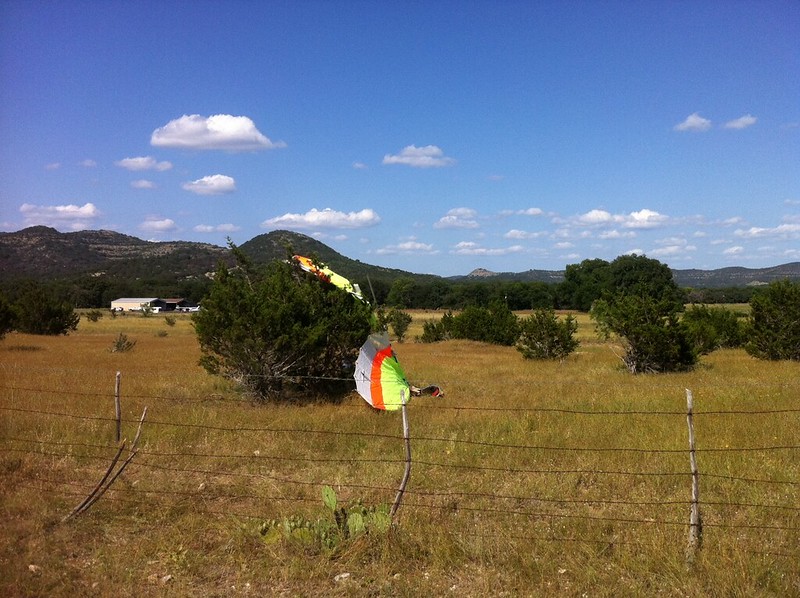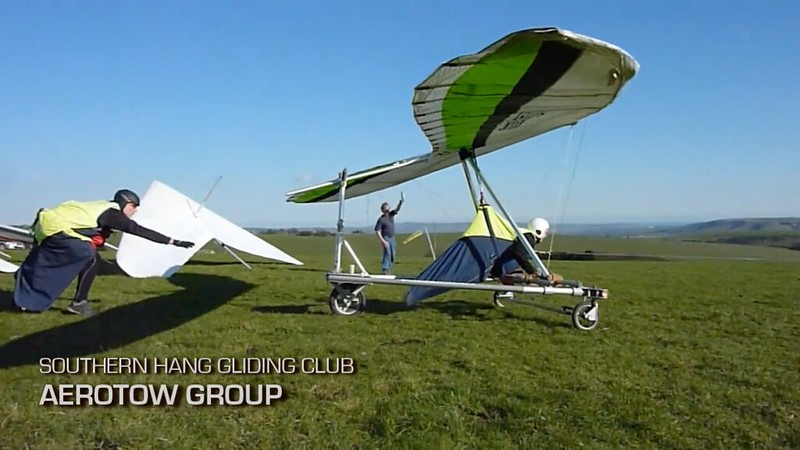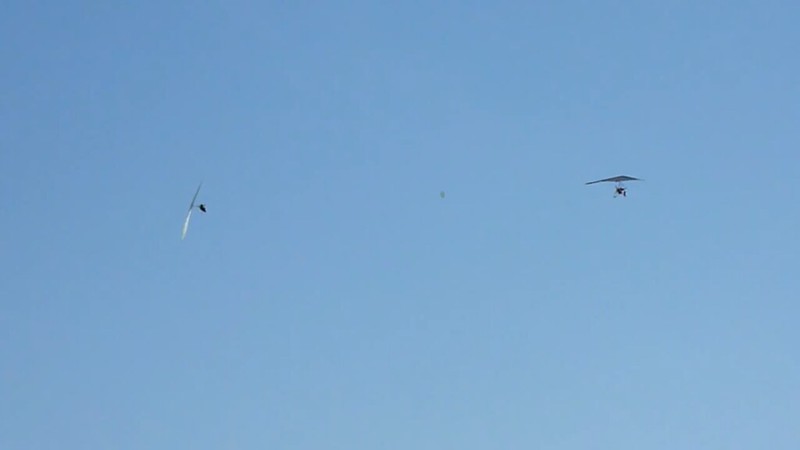Platform towing /risk mitigation / accident
You're also pulling out line at a predetermined and constant tension so if you happen to stray a bit out of the sweet spot a lockout is a far from a foregone conclusion.Bill Cummings - 2012/07/20 05:11:46 UTC
When towing:
Where will I find the sweet spot? How big will it be? Does it change in size for any reason?
The towing sweet spot will be found downwind of the tow vehicle of course.
If the wind is right smack dab down the center of the runway/tow road being in the sweet spot is straight forward. Just stay directly behind the truck.
The sweet spot will be very narrow right after platform launching. In other words if you get just a little to the left or right of the tow vehicle with a short rope to the tow vehicle you can find yourself locked out in no time at all.
So maybe racing the vehicle away from the glider shortly after it launches isn't a totally terrible idea.The more towline/rope that you have between the tow vehicle and your glider the wider, left and right, the sweet spot will be.
And the glider can climb more quickly and at a higher airspeed through the kill zone so there are some tradeoffs involved in that one as well.When you increase the towline tension the sweet spot narrows.
How many that are unpredictable and/or unavoidable?At times a spool with too much rope on it will allow the towline to dig in and prevent the spool/reel from paying out rope. This will increase you line tension and narrow your sweet spot.
A warped disc brake can drag and change the line tension.
If a rag or glove blows in between the chain and sprocket of your rewind or in between your pulley and belt of a rewind this can lock up the winch/reel.
If the chain climbs a worn sprocket it can lock up the winch.
If you splash through a big puddle on the dirt road and get dirt on the disc that will increase your line tension by causing more friction between the disc and brake pads. Believe me there are many more things that can happen to increase the line tension and reduce the size of the sweet spot that you were enjoying.
Then maybe we really shouldn't be flying. Or maybe we should should go into Stuart Caruk mode and throw in a three quarter G weak link and assume that it'll solve whatever problem we may encounter - without causing any of its own in any circumstances we may encounter.With enough time anything that can go wrong probably will.
Hey, here's a thought...But we can all adopt procedures the will answer all of the known probabilities.
- We use platform launch systems so the crew members - the guy under the glider and one(s) on the vehicle - can control the tow according to their judgment and decisions.
- When we have malfunctions which result in deviations from the flight plan - vehicle speed, airspeed, tow tension, tow angle, glider attitude, people can die (as Sam, Martin, and Terry so recently and definitively demonstrated). They can die just as abruptly and permanently as they can as a consequence of a sidewire failure or unhooked launch.
- Problems with warped disc brakes, loose rags and gloves, and worn sprockets can be at least as easily and totally taken out of the equation as sidewire failures.
- Ditto with respect to towline, weak link, and release failures.
- And it's not like puddles jump out in front of us without warning.
- So let's point these risks out, put them on the preflight checklist, and then not discuss them any more.
- Line dig - we can greatly mitigate that risk.
With the possible the possible exception of a line dig, you haven't mentioned anything that Murphy's throwing at us that we can't stop him from throwing at us.I have noticed operations that have strayed from good procedures.
Things that can be done to mitigate things that Murphy will throw at you follow.
Murphy's Law states that anything that CAN go wrong WILL go wrong. And in aviation we can't afford to have things under our control going wrong 'cause we've got all the variation and unpredictability we need getting thrown at us by Ma Nature.
So if we can make the fuckin' one point bridle so short that it's incapable of wrapping...
http://www.hanggliding.org/viewtopic.php?t=14230
pro tow set-up
...we make the fuckin' one point bridle so short that it's incapable of wrapping.Jim Rooney - 2009/11/02 18:58:13 UTC
Oh it happens.
I have, all the guys I work with have.
(Our average is 1 in 1,000 tows)
And there's a corollary to Murphy's Law that says that if something can go wrong it will go wrong at the worst possible moment.
And the assholes at Ridgely are pretty good at proving that one right too.Oh yeah... an other fun fact for ya... ya know when it's far more likely to happen? During a lockout. When we're doing lockout training, the odds go from 1 in 1,000 to over 50/50.
I'm not particularly interested in what you...I don't think accelerating through the launch window speed is a good idea.
...or anyone else thinks or believes. Gimme some numbers, data, logic, hypothetical situations.Stuart Caruk - 2010/03
Most reliable sources believe that a weaklink should be sized so that it breaks at 75% to 100% of the inflight load.
So it sounds like your doing and benefiting from some measure of what you're criticizing here:At my altitude my launch speed with no wind is a steady 32 miles per hour (double surface glider not a Falcon). At that speed and not hooked to the towline I can launch and climb to thirty to fifty feet behind the truck, round off the climb and land on the road again as the truck goes away still at 32 mph. The Sweet Spot never even enters the equation.
Hooked to the towline I prefer to launch with low tension. Just enough to keep the winch from back lashing. When I stop climbing the preset tension is allowed to be applied to the towline. For the low tension launch I am almost totally in free flight. The towline has very little affect on me. Once the preset tension is applied I now have to concern myself with staying in the sweet spot. Which will be much broader with all the line I have pulled off of the winch/reel.
And I'll bet you're doing it and getting along just fine...Bill Cummings - 2012/07/18 05:45:32 UTC
And another thing, -- darn it!-- What is with all the Youtube video's of experienced tow people dashing out from under the glider and paying out rope until the tow vehicle has a fifteen degree angle on the tow line to the ground?
...without benefit of a two point configuration.If you want to do that use a rope to the keel so it won't wallow and tip stall because of too much angle of attack. (AOA).
But are we seeing any launch incidents precipitated by people blasting off from the platform with lotsa speed under lotsa tension?
Zack C - 2011/03/04 05:29:28 UTC
As for platform launching, I was nervous about it when I started doing it. It looked iffy, like things could get bad fast. I've since logged around a hundred platform launches and have seen hundreds more. Never once was there any issue. I now feel platform launching is the safest way to get a hang glider into the air (in the widest range of conditions). You get away from the ground very quickly and don't launch until you have plenty of airspeed and excellent control.
1. If you miss the release the first time there's no one holding a gun to your head forcing you to launch with too much speed.Accelerating through the launch window can have me launching with too much speed if I miss the release the first time with some rigs.
2. What? People can't even design nose releases for the rig which can be reliably blown at will?
3. There've been a lot of people who've missed tow releases the first time who didn't get chances for second shots in time for them to matter.
That's OK, Bob's entire little organization experiment isn't really working either.I prefer to radio to the tow vehicle, "Clear!" Have them trip the nose release. Then when I see that I'm free of the nose release I rock back anytime and launch. You need hand holds for this to keep you in the launch yokes.
It 12:02 am here in Minnesota so I'll try to finish this after my road trip. (Second try first attempt didn't work.)


